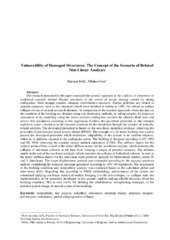Приказ основних података о документу
Vulnerability of Damaged Structures: The Concept of the Scenario of Related Non-Linear Analyses
| dc.creator | Folić, Radomir | |
| dc.creator | Ćosić, Mladen | |
| dc.date.accessioned | 2023-12-12T09:37:07Z | |
| dc.date.available | 2023-12-12T09:37:07Z | |
| dc.date.issued | 2014 | |
| dc.identifier.uri | http://rims.institutims.rs/handle/123456789/739 | |
| dc.description.abstract | The research presented in the paper employed the general approach in the analysis of robustness of reinforced concrete skeletal (frame) structures in the events of severe damage caused by strong earthquakes. Such damage requires adequate rehabilitation measures. Similar problems are related to incident situations, such as the structures which were bombed in Serbia in 1999, fire effects or sudden collapse of one or several structural elements. In comparison to the classical approach, where the data on the condition of the building are obtained using non-destructive methods, by taking samples, by empirical assessment or by modelling using the linear analyses, taking into account the ultimate limit state and service life calculation according to the regulations (Codes), the procedure presented in this research enables to make a decision on the structure condition by the simulation through the scenario of mutually related analyses. The developed procedure is based on the non-linear numerical analyses, observing the principles of performance based seismic design (PBSD). The example of a 10 storey building was used to present the developed procedure which determines adaptability of the system in an incident situation, which is, in addition, exposed to the earthquake action. The building is designed according to EN 1992 and EN 1998, observing the capacity design method calculation (CDM). The stiffness matrix for the vertical action effects is used as the initial stiffness matrix for the non-linear analysis, which simulates the collapse of individual columns at the base floor, forming a couple of possible scenarios. The stiffness matrix at the end of the non-linear analysis, which simulates the collapse of individual columns, is used as the initial stiffness matrix for the non-linear static pushover analysis for bidirectional seismic action (X and Y directions). The target displacement analysis was conducted according to the capacity spectrum method, considering the response spectrum generated according to ATC 40 regulations. The assessment of the building condition and vulnerability analysis was conducted based on the calculated global and inter-storey drifts. Regarding that according to PBSD methodology, performances of the system are considered applying non-linear numerical models, bringing it to the near-collapse, i.e. collapse state, the implementation of the procedure developed in this manner, enables making reliable decisions about the building condition. This is very useful for defining the rehabilitation, strengthening strategies, or for potential partial change of statical system of the building. | sr |
| dc.language.iso | en | sr |
| dc.publisher | Varna Free University “Chernorizets Hrabar”, Varna, Bulgaria | sr |
| dc.relation | info:eu-repo/grantAgreement/MESTD/Technological Development (TD or TR)/36043/RS// | sr |
| dc.rights | openAccess | sr |
| dc.rights.uri | https://creativecommons.org/licenses/by-sa/4.0/ | |
| dc.source | 13th International Scientific Conference, Varna, Bulgaria | sr |
| dc.subject | vulnerability | sr |
| dc.subject | risk analysis | sr |
| dc.subject | reliability | sr |
| dc.subject | robustness | sr |
| dc.subject | structural failure | sr |
| dc.subject | structural integrity | sr |
| dc.subject | performance | sr |
| dc.subject | redundancy | sr |
| dc.subject | partial and progressive collapse | sr |
| dc.title | Vulnerability of Damaged Structures: The Concept of the Scenario of Related Non-Linear Analyses | sr |
| dc.type | conferenceObject | sr |
| dc.rights.license | BY-SA | sr |
| dc.citation.epage | 10 | |
| dc.citation.spage | 1 | |
| dc.identifier.fulltext | http://rims.institutims.rs/bitstream/id/1588/bitstream_1588.pdf | |
| dc.identifier.rcub | https://hdl.handle.net/21.15107/rcub_rims_739 | |
| dc.type.version | publishedVersion | sr |

